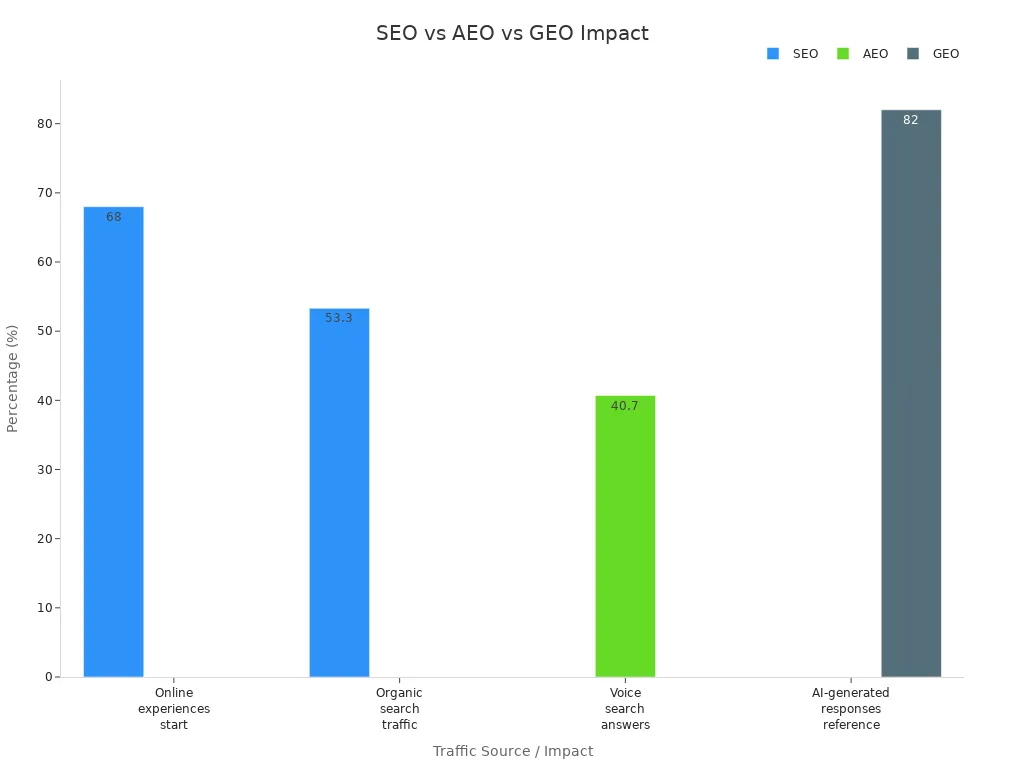Do You Need SEO, AI Optimization, GEO, or AEO for Better Search Results

Businesses must choose what to focus on. They can use Search Engine Optimization, ai optimization, or try GEO and AEO. In 2024, ai-driven search changes how people look for answers. Ai systems like RankBrain and BERT help search engines understand what users want. This helps show better results. Now, one in ten users start with ai-driven search. Ai-powered search tools like Google AI Overviews and ChatGPT answer millions of questions every day. Users talk to content directly and often skip clicking on links. Good content stands out because ai likes clear and trusted information.
Ai and content change how people use search, so strong content is important for every business.
Key Takeaways
SEO, AEO, and GEO each have their own jobs. SEO brings people to websites using search engines. AEO gives fast answers with voice and snippets. GEO helps content work well on AI platforms and chatbots.
Good content is important for all these plans. It should be strong, clear, and trustworthy. Using structured data, natural language, and expert facts helps content get noticed in search results.
Businesses pick plans based on what they want and who they serve. Small or local businesses should use SEO first. Bigger or tech-focused companies can add AEO and GEO to reach more AI users.
Using SEO, AEO, and GEO together makes a strong marketing plan. This helps people see your business on search engines, voice assistants, and AI chatbots.
Update your content often and check how it is doing with the right numbers. Change your plan when new AI search trends appear. This helps businesses stay ahead as search changes.
Comparison: SEO, GEO, AEO, AI Optimization

Main Focus
SEO, AEO, GEO, and AI optimization help people find information in different ways. SEO helps websites show up on search engines like Google and Bing. It uses keywords, links, and tech fixes to make websites easier to find. AEO gives users direct answers using things like voice assistants and featured snippets. GEO changes content so ai chatbots and search tools can use it. AI optimization makes content simple for ai models to read and use.
Optimization Type | Main Focus | Target Platform | Content Style | User Behavior | Best For |
|---|---|---|---|---|---|
SEO | Google, Bing | Keyword-rich, long-form, technically optimized | Browsing SERPs to visit websites | E-commerce, local businesses, service providers | |
AEO | Providing clear, direct answers for voice, snippets, and zero-click results | Voice assistants, featured snippets, knowledge panels | Concise, question-focused, natural language with schema markup | Seeking instant answers via voice or snippets | Mobile users, voice search users, informational queries |
GEO | Securing citations in ai-generated conversational answers | AI-driven generative engines (ChatGPT, Google SGE, Bing Chat) | Conversational, fact-rich, authoritative with citations and structured data | Interacting with ai chatbots for synthesized answers | Tech-savvy, ai-focused industries and audiences |
SEO is for people who use search engines to look for websites. AEO is for people who want fast answers without clicking links. GEO is for people who talk to ai chatbots and want detailed answers. AI optimization gets content ready for ai search and generative engines.
Strengths
SEO is still the best way to get steady website traffic. It uses keyword research, links, and tech fixes to help websites rank higher. More than half of website visits come from organic search. SEO makes it easy for people to find websites and services.
AEO is great at giving direct answers. It uses structured data, clear questions and answers, and schema markup. This helps content show up in featured snippets and voice searches. People get quick and correct answers. AEO helps content show up in zero-click results and voice searches.
GEO changes content for ai-driven search. It focuses on facts, trust, and context. GEO helps content show up in ai-generated answers and summaries. AI models use clear and structured content to answer hard questions. GEO helps brands get mentioned more in ai results and gives people reliable information.

GEO also helps with local search. It uses local keywords, Google Business Profile, and local mentions. Businesses can show up higher in local search and maps. AEO makes direct answers better by using friendly phrases and FAQ formats. Both help people find local products and get exact answers.
Aspect | GEO (Geographic Engine Optimization) | AEO (Answer Engine Optimization) |
|---|---|---|
Focus | Optimizing for local and location-based searches | Providing direct answers to voice and text queries |
Primary Goal | Improving visibility in local search results and Google Maps | Appearing in featured snippets and voice search results |
Target Audience | Users looking for nearby products or services | Users seeking quick, precise answers |
Optimization Strategy | Local keywords, Google My Business profile, local citations | Conversational content, schema markup, FAQ formats |
Content Type | Location pages, local blog posts, event promotions | FAQ pages, how-tos, short and concise answers |
User Intent | Transactional with a local intent | Informational and transactional |
Technology Leveraged | Google Maps, local directories, mobile local search | Voice assistants, featured snippets |
Metrics / KPIs | Local search rankings, Google Business Profile insights, review acquisition | Featured snippet captures, voice search optimization scores, FAQ engagement |
Best Use Cases
SEO is best for businesses that want more website visitors and to be seen online. Online stores, local shops, and service companies get the most from SEO. SEO helps people find products, services, and info on search engines.
AEO is best for businesses that want to reach mobile users, voice search, and people looking for info. Health clinics, roofing companies, and stores use AEO to show up in featured snippets and voice search. People get fast answers and can book services quickly.
GEO is good for tech-savvy businesses and audiences. B2B SaaS companies, eco-friendly stores, and consultancies use GEO to get more ai mentions and brand awareness. GEO helps content show up in ai search and chatbots. People use ai to get detailed, friendly answers.
B2B SaaS companies got more ai mentions by working with trusted blogs and growing their Wikipedia pages.
Eco-friendly stores used FAQ schema and got their community to talk about them, so they showed up more in ai search.
Consultancies shared expert advice and got quoted often in ai-driven platforms.
AEO works for all answer engines, like search, voice assistants, and ai chatbots. GEO is for generative ai models. Big, digital businesses do best with SEO, GEO, and AEO together. Small businesses should start with SEO and add AEO as they grow.
Aspect | SEO | GEO | AEO |
|---|---|---|---|
Platforms | Traditional search engines (Google, Bing) | Generative AI models (ChatGPT, Gemini) | All answer engines incl. voice assistants, AI chatbots |
Content Interpretation | HTML tags, keywords, backlinks | Prose, tables, JSON-LD, context, token probability | Conversational queries, citations in AI answers |
User Intent | Exact match keywords (e.g., “best CRM”) | Contextual, conversational, anticipates follow-ups | Conversational, long-tail, immediate answers |
Optimization Focus | Keywords, backlinks, domain authority | Structured data, context embedding | Clear answers, schema markup, citations in AI responses |
Business Suitability | Foundational for all; essential for smaller or less mature businesses | Benefits mature businesses with digital sophistication | Best for larger, digitally mature businesses integrating multiple strategies |
Outcome | Organic rankings, traffic | AI citations, conversational relevance | Brand visibility across AI and traditional platforms |
SEO and AEO are different in how they rank and what users see. SEO tries to rank high and get people to click on websites. People pick from a list of pages. AEO wants content to be the answer itself. People might get info without visiting the site. SEO uses keywords and long content. AEO uses short answers and clear formats. SEO checks success by clicks and visits. AEO checks how often it shows up in ai answers and brand mentions.
Aspect | SEO (Search Engine Optimization) | AEO (Answer Engine Optimization) |
|---|---|---|
Primary Goal | Rank high in search results to drive clicks to your site. Users select your page from a list. | Be selected or cited as the direct answer to a user’s query. Users may get info without visiting your site. |
User Query Format | Keywords or short phrases (e.g., “running shoes flat feet”). | Full questions or natural language prompts (e.g., “What are the best running shoes for flat feet?”). |
Content Format | In-depth, comprehensive content covering topics thoroughly, including long-form text and images. | Concise, specific answers structured for easy extraction, often using Q&A, bullet points, or summaries. |
Ranking Factors | Based on search engine algorithms: keyword relevance, content quality, backlinks, page experience. | Influenced by traditional SEO factors but also emphasizes content structure, clarity, and accessibility to AI crawlers. |
Technical Optimization | Standard SEO: crawlable site, fast/mobile-friendly, proper HTML tags, image alt text, schema for rich results. | Structured data (schema markup) is crucial; content must be accessible to AI bots; avoid info only in images/PDFs. |
User Engagement Outcome | Success measured by clicks, traffic, and conversions; engaging titles and meta descriptions entice clicks. | Success measured by visibility in AI-generated answers, brand authority gained even without clicks; citations may drive traffic. |
AI optimization, or GEO, builds on SEO by focusing on meaning and what users want. GEO uses structured data, short formats, and puts user needs first. AI search engines use natural language to make summaries and answers. Content must be clear, complete, and fit the topic. GEO changes SEO for ai search and generative engines.
Aspect | ||
|---|---|---|
Keyword Optimization | Incorporates relevant keywords to improve visibility | Also uses keywords but optimized for AI understanding and context |
Content Quality | High-quality, informative, engaging content | Emphasizes clearer structure, explicit answers, and AI-friendly formats |
User Intent Understanding | Aligns content with user search intent | Prioritizes user intent with AI-driven intent analysis tools |
Technical SEO | Site speed, mobile-friendliness, crawlability | Includes new technical considerations like structured data for AI |
Authority & Trust | Builds domain authority via backlinks and trust | Focuses on E-E-A-T principles with explicit signals for AI |
Content Structure | Flexible formats including long-form articles | Prefers concise summaries, bullet points, FAQs for AI readability |
Query Focus | Broad range: informational, navigational, transactional | Targets queries AI summaries cover: direct questions, definitions |
Metrics & Goals | Click-through rates, bounce rates, time on page | Visibility of citations, relevance to user query, AI-driven metrics |
SEO, GEO, and AEO all help people find what they need. Businesses should pick the strategy that matches their goals, audience, and how digital they are. SEO is needed for every business. GEO and AEO help bigger, more advanced businesses reach people on ai search and answer engines. Using AEO and GEO early gives businesses an edge as ai search grows.
When to Use Search Engine Optimization
SEO for Web Search
Search engine optimization helps businesses get found online. It is good for people searching for products or services. SEO works best when people use search engines for answers. Stores, clinics, law firms, and real estate agents use SEO to get more visitors. Local places like restaurants and pet groomers use SEO too. They want to show up in searches like “pizza near me.” SEO brings in visitors by matching what people want with the right content.
Tip: Businesses should use good keywords and make helpful content. This helps bring in users and give them what they need.
AI changes how search engines work now. Content that answers questions clearly does better. SEO is still important, but businesses must change how they do it. People ask questions in normal language. AI models can understand what people mean. SEO now means making content for what people want, and fixing things like site speed and mobile use.
Industry | SEO Needs | Key Considerations |
|---|---|---|
E-commerce | Product visibility, category ranking, local SEO | High competition, technical SEO, content marketing |
Healthcare | Local SEO for clinics and medical practices | Compliance, content accuracy, local search |
Legal Services | Local SEO for law firms, content marketing | High competition, trust and authority in content |
Real Estate | Local SEO for listings, market content | Regular updates, mobile optimization, local keywords |
Hospitality | SEO for hotels, restaurants, travel agencies | Local search, user-generated content, reputation |
Financial Services | SEO for banks, insurance, investment firms | Regulatory compliance, content accuracy, competition |
Education | Tailored SEO strategies | N/A |
Other services like home repairs and big companies with many locations use SEO too. They want to reach people looking for local help. Online-only businesses need SEO because they do not have stores.
SEO Metrics
SEO works best when you track the right things. Businesses look at organic traffic to see how many people visit from search. Impressions show how often a page shows up in results. Clicks tell how many people pick a site after seeing it. Keyword optimization helps check which words work best. Engagement metrics, like bounce rate and time on page, show if people like the content.
Impressions: Shows how often your page is seen in search.
Clicks: Counts how many people visit from search engines.
Organic traffic: Measures how many people come from search.
Keyword rankings: Checks how well your keywords do.
Engagement metrics: Looks at bounce rate and time spent.
Click-through rate (CTR): Finds the percent of views that become clicks.
Share of voice: Compares your search visibility to others.
Conversion metrics: Tracks actions like buying or signing up from search.
AI changes in search make some old metrics less useful. CTR is not enough by itself now. Businesses use engagement, visibility, and conversion together. SEO plans must change as AI changes. Focus on what users want, good content, and a great experience. Keep checking and updating SEO to keep your traffic and rankings.
When to Use Answer Engine Optimization
AEO for Direct Answers
Answer engine optimization helps businesses reach people who want quick answers. Many people use ai search tools, voice assistants, and chatbots now. These users want to get answers right away. To help them, writers make content easy for ai to find and use.
Content for answer engines starts with knowing what questions people ask. Writers use tools like “People Also Ask” and Answer the Public to learn what people want. They organize topics by what users need. Short paragraphs, bullet points, and clear headings help ai read content easily. FAQ sections and schema markup, like FAQPage or HowTo, help ai show answers.
Clear summaries and question headings help content get featured.
Bullet points and tables help ai find important facts.
Schema markup tells ai which parts answer common questions.
Businesses should keep content new and original. Sharing data from surveys or case studies makes content special. Updating content often shows ai that it is current and trustworthy.
Authority in AI Search
Ai search engines look for trust and authority before showing answers. They use the E-E-A-T framework: Experience, Expertise, Authoritativeness, and Trustworthiness. Content with real experience, deep knowledge, and clear credentials ranks higher.
To build authority, businesses should:
Add author bios with credentials to show expertise.
Get citations and backlinks from trusted sites.
Check every fact and link to original sources.
Share any affiliations or sponsored content.
Update content and show version histories.
Ai also checks for technical quality. Fast pages, mobile-friendly design, and clear formatting help ai trust the content. Using semantic HTML and structured data makes it easier for ai to pick the best answers.
Note: Content that matches what users want, uses natural language, and gives direct answers will do best in answer engine optimization.
A strong answer engine optimization plan helps businesses show up in featured snippets, knowledge panels, and ai-powered answer engines. This helps more people see the business and trust its answers.
Generative Engine Optimization in AI Search

GEO for AI Responses
Generative engine optimization changes how businesses use ai search. It does not just focus on ranking high. Instead, it helps content become part of ai answers. This method updates traditional SEO. Content must be clear and easy for ai to read.
Generative engine optimization pays attention to ai engines that make answers.
It likes clear, well-organized, and short answers for ai.
Content should follow E-E-A-T rules: experience, expertise, authoritativeness, and trustworthiness.
Using structured data and schema markup helps ai find key facts.
Generative engine optimization uses keywords from natural, everyday questions.
It needs regular checks to see how often ai mentions the content.
The goal is not just clicks but being shown in ai answers.
Businesses get new benefits from generative engine optimization. They check how often ai mentions their brand, not just website visits. The table below shows how these benefits compare to standard SEO:
Benefit / Metric | Description | Comparison to Standard SEO |
|---|---|---|
Brand cited in ai-generated answers | GEO uses citations, SEO uses clicks and rankings | |
Brand Visibility | Direct mentions in ai responses | GEO gains visibility in zero-click environments |
Referral Signups | Signups from ai platforms referencing the brand | GEO can outperform paid search in referrals |
User Engagement | Longer sessions after ai citations | GEO captures engagement from ai answer exposure |
ROI Improvements | Brand lift and referral signups via ai citations | GEO can exceed traditional paid search ROI |
Generative engine optimization works with SEO to keep content seen as ai search grows.
Multi-Modal Platforms
Multi-modal platforms change how content shows up in ai search. These platforms use more than just words. They mix images, videos, voice, and interactive parts. Ai now looks at all these formats to give better answers.
Multi-modal ai pipelines study content directly, not just search queries.
Ai uses vision-language models to match and pull facts from images, videos, and text.
Content needs structured data, like schema markup, so ai can understand products, events, and how-tos.
Visuals like diagrams, screenshots, and video guides help answer hard questions.
Alt-text, transcripts, and labels make content easier for ai to use.
Users want search results with text, pictures, and interactive features. Just plain text is not enough. Content must show how things work and give clear signals for ai search ranking. This change means businesses must make content for both regular and ai search, so it works on any platform.
Quality Content for All Strategies
Building Authority
Good content is very important for every strategy. SEO and GEO like new and well-organized content. Content made by experts helps people and search engines trust you. Brands can get noticed by sharing on Google, ChatGPT, LinkedIn, and YouTube. These mentions show trust for both regular and ai search.
To build authority, brands should:
Share expert content that answers real questions.
Use author bios and credentials to show expertise.
Get mentions and citations from trusted websites.
Keep content updated and correct.
Talk with people on social media and forums.
Publishing often and talking with others helps brands get known. Good content that follows E-E-A-T rules gets seen more in ai and search results. AI systems pick the best sources, so great content makes you more trusted.
Relevance for AI and Search Engines
AI and regular search engines look for different things. Regular engines check keywords and trust signals. AI search engines use context and patterns. They look at each paragraph, so every paragraph should have one clear idea.
Aspect | AI Search Engines (GenAI) | Traditional Search Engines |
|---|---|---|
Paragraph-level, context-rich, standalone segments | Page-level, keyword and authority signals | |
Query Understanding | Deep semantic and intent recognition | Keyword-based |
Optimization Focus | Authoritative, structured, and comprehensive content | Keyword-based SEO and page authority |
To make good content for all strategies, brands should:
Use structured data and schema markup.
Write in a natural, friendly way.
Update info often to keep it fresh.
Making good content means thinking about what users want, giving clear answers, and making info easy for ai and people to read. This helps you rank better, get more mentions, and build trust everywhere.
Integrating SEO, GEO, and AEO
Combining Approaches
Businesses need a plan that works everywhere people search. They can use seo, GEO, and AEO together to reach more users. Each method helps in a different way. Seo makes sure websites work well for search engines. AEO helps content give fast answers. GEO lets ai models find and credit the content.
To make a strong marketing plan, companies can do these things:
Study what users want by looking at search intent. This helps match content to what people are looking for.
Change content by adding FAQs and clear headings. This helps AEO and makes it easy for ai to find answers.
Use schema markup and structured data. These help search engines and ai models see what is important.
Make content that follows E-E-A-T rules. This builds trust and helps content stand out in search and ai.
Watch for changes in search results and ai engines. This helps keep the plan up to date.
Using all three methods helps businesses get seen on every platform. Companies that use these strategies together get more visitors and clicks. Some agencies saw up to 25% more ai traffic each month by using seo, AEO, and GEO. This also helps brands show up in featured snippets, voice search, and ai chat.
Businesses should also research keywords and questions. They need to use both regular and conversational queries for seo and AEO. Optimizing for both rankings and direct answers helps reach users everywhere. Long, well-sourced content helps ai models and gets more citations in ai answers.
Tip: Put your content on many platforms to build trust and get more ai citations.
Tracking results on all channels is important. Companies should use analytics and ai tools to check rankings, snippets, voice results, and ai citations. Checking and updating content often keeps the plan working as search changes.
Adapting to Search Evolution
Search changes fast. Businesses must change their plans to keep up. Voice search, ai answer engines, and new platforms change how people find info. Companies that update their content and seo for these tools stay ahead.
Now, many businesses focus on what users want, not just keywords. They make good, original content that shows they are experts. This works for both regular search and ai features like AI Overviews. Companies also use long-tail and question-based queries. This helps reach people who use voice search or ask hard questions.
Local seo is still important. Businesses update Google Business Profiles, manage reviews, and use local citations to get seen. They also use structured data and metadata to help ai understand images and media. Some try new things like augmented reality to help users and boost local seo.
Personalization is growing. Companies use their own data to make content for different groups. This makes users happier and keeps them interested. As ai gets bigger in search, businesses must keep changing their plans. They need to focus on brand, reputation, and trust to stay seen.
To check how well they are doing, businesses can use this table:
Competency | Description | Key Evaluation Criteria / Metrics |
|---|---|---|
Data Foundations | Makes sure data is trusted, tracked, and easy to use. | Clear goals, trusted sources like Google Analytics, team ownership, and data-based choices. |
User-Centered Approach | Focuses on knowing what users do and want. | Roadmap for user needs, team knows audience, uses 5-Factors Scorecard™. |
Resourcing (Skills) | Has people with skills in research, marketing, design, and tech. | Number of skills, time spent, experiment list size, research often, testing ways. |
Toolkit | Uses tools and steps for planning and testing digital ideas. | Uses frameworks like RICE, ICE, PIE; makes good guesses; tries many experiments fast. |
Impact & Buy-In | Leaders support and look for results beyond just sales. | Number of research projects, tests, changes made, teams use insights, more revenue and ROI. |
Companies should set clear goals for GEO and seo. They need to research keywords for seo and learn best ai prompts for GEO. Making good content means mixing ai drafts with seo edits. Testing and checking both GEO and seo shows what needs work. Changing plans based on data and trends helps businesses win over time.
Note: Using a flexible, multi-platform plan helps businesses grow as search changes. Mixing seo, GEO, and AEO keeps your brand strong and brings in more visitors from everywhere.
Picking the best strategy depends on what your business wants and who your customers are. The table below shows how SEO, GEO, and AEO each work on different platforms and use different methods. Businesses need to make content that answers questions and builds trust with users. Ai is changing how people search for things, so companies must change fast too. Checking your plan often helps your content stay easy to find and useful. Ai platforms need content that is organized and easy to read. Teams should watch how content is doing and update it as search tools get better. Ai likes content that is clear and comes from trusted sources. Using SEO, GEO, and AEO together helps more people see your business. Ai search is growing quickly, so checking your plan often keeps you ahead. Content that helps users will always stand out in search results.
Factor | SEO | AEO | GEO |
|---|---|---|---|
Primary Goal | Improve webpage rankings on search engines | Deliver direct answers to user queries | Optimize content for AI-driven platforms |
Focus Area | Keywords, backlinks, technical SEO | Question-based content, featured snippets | Conversational content, semantic relevance |
User Intent | In-depth, informational content | Instant answers, zero-click results | Problem-solving, AI-generated responses |
Platforms | Google, Bing, Yahoo | Voice assistants (Google SGE, Alexa, Siri) | AI chatbots and models (ChatGPT, Gemini) |
Techniques | On-page SEO, link building, keyword targeting | FAQ schema, structured data, voice search optimization | Structured content, descriptive headings, EEAT guidelines |
Best Use Cases | E-commerce, service sites targeting organic traffic | Local businesses aiming for voice search and snippets | Tech-savvy audiences, AI-driven search queries |
FAQ
What is the difference between SEO and GEO in ai search?
SEO helps websites show up in search engines. GEO makes content easy for ai models to find. GEO helps brands get mentioned in ai answers. Both help users find info, but GEO works best for ai platforms.
How does AEO improve visibility in ai-powered results?
AEO gives clear answers and uses structured data. This helps ai engines pick good content for direct answers. Businesses get seen more in featured snippets and voice search. AEO helps users get fast replies from ai tools.
Why should businesses optimize for multi-modal ai platforms?
Multi-modal ai platforms use text, pictures, and videos. Businesses that add visuals and clear labels help ai understand their content. This makes it easier to be included in ai answers. Users get better info from different formats.
How can companies track success in ai search optimization?
Companies check citation frequency, brand mentions, and user engagement. They use analytics to see how often ai platforms show their content. Tracking these numbers helps businesses improve their ai strategies and reach more users.
What role does quality content play in ai optimization?
Quality content builds trust and shows authority. Ai engines pick sources with clear and correct info. Businesses that update content and show expertise get more mentions in ai answers. Good content helps users and improves results everywhere.





